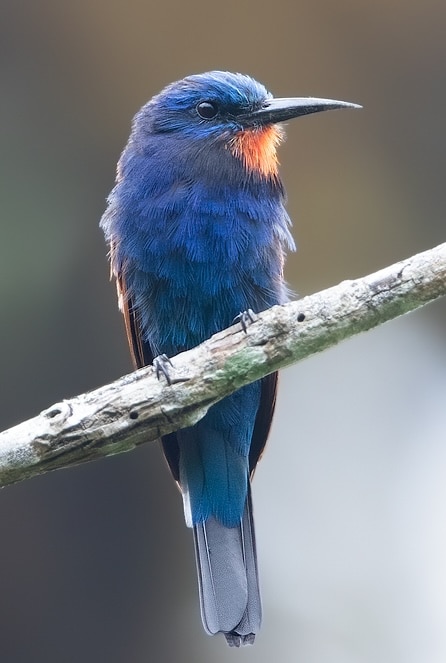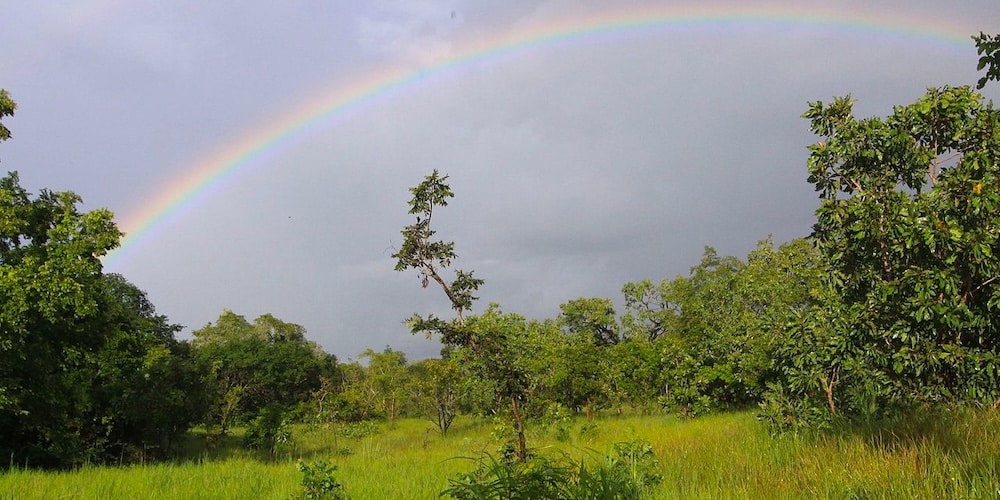Republic of Côte d’Ivoire

Côte d’Ivoire also known as the Ivory Coast is a country on the southern coast of West Africa. It borders Guinea to the northwest, Liberia to the west, Mali to the northwest, Burkina Faso to the northeast, Ghana to the east, and the Atlantic Ocean’s Gulf of Guinea to the south. With over 33 million inhabitants in 2024, Ivory Coast is the third-most populous country in West Africa. Its capital city of Yamoussoukro is located in the centre of the country with a population of around 0.25 million, while its largest city with a population of over 6 million people and the economic centre for the country is the port city of Abidjan. Its official language is French, and indigenous languages are also widely used, including Bété, Baoulé, Dyula, Dan, Anyin, and Cebaara Senufo. In total, there are around 78 languages spoken in Ivory Coast. The country has a religiously diverse population, including numerous followers of Islam, Christianity, and traditional faiths often entailing animism.
Around 64.8% of the land is agricultural land; arable land amounted to 9.1%, permanent pasture 41.5%, and permanent crops 14.2%. Water pollution is one of the biggest issues that the country is currently facing.

Taï National Park – ©yakovlev.alexey CC BY-SA 2.0 via Wikimedia Commons
The climate is generally warm and humid, ranging from equatorial in the southern coasts of the Gulf of Guinea, tropical in the middle and semiarid in the far north.
Birding the Ivory Coast
It is the most biodiverse country in West Africa, with the majority of its wildlife population living in the nation’s rugged interior. The country contains six terrestrial eco-regions: Eastern Guinean forests, Guinean montane forests, Western Guinean lowland forests, Guinean forest–savanna mosaic, West Sudanian savanna, and Guinean mangroves.
The climatic range creates very diverse biotopes for the local avifauna, which provides a bird list of over 740 species. There are also more than 220 mammals, 125 reptiles, 35 amphibians and 111 fish as well as 4,700 native plant species.

Bandama River – ©Zenman CC BY-SA 3.0 via Wikimedia Commons
There are 13 IBAs in the Ivory Coast, but conservation has for a long time not been a priority, so some of them are badly degraded. However, the management of natural areas has recently begun to improve considerably so there is hope! The nation now has nine national parks, the largest of which is Azagny National Park which occupies an area of around 17,000 hectares or 42,000 acres.
Nevertheless, three top sites offer huge birding opportunities, along with safe and quite comfortable visiting conditions (see Top Sites). There are guiding facilities in several places.

Comoé National Park – ©ETF89 CC BY-SA 4.0 via Wikimedia Commons
After years of political turmoil, the country is now more accessible to independent birders, able to deal with the absence of specialised agencies.
-
African Bird Club List of Sites
Webpage -
Banco National Park
InformationSatellite ViewThe Parc National du Banco is a secondary and primary forest adjoining Abidjan. It will provide a nice introduction to Upper Guinean forest's birds. Uncommon birds like Bates's Sunbird, Copper-tailed Starling, or Least Honeyguide may be encountered, among a bird list of about 200 species. Perfect for a birding session while on a business trip. Guiding facilities at the gate of the park, which is known by most taxi drivers in Abidjan. -
Comoé National Park - Parc National de la Comoé
InformationSatellite ViewParc National de la Comoé is a Biosphere Reserve and UNESCO World Heritage Site in the Zanzan and Savanes Districts of north-eastern Ivory Coast. It is the largest protected area in West Africa, with an area of 11,500 km2, and ranges from the humid Guinea savanna to the dry Sudanian zone; a large wooded savannah area near the Burkina and Ghana borders. Top species there are Marabou Stork, Bateleur (50 species of diurnal birds have been listed!), Denham's Bustard, Abyssinian Ground Hornbill and more than 450 other species. -
Taï National Park - Parc National de Taï
InformationSatellite ViewThe Parc National de Taï is one of the most beautiful primary forests in West Africa. Some of the much sought after species found here include Red-thighed Sparrowhawk, White-breasted Guineafowl, Nkulengu Rail, Red-Chested Owlet, Yellow-casqued Hornbill, Western Wattled Cuckoo-shrike, Yellow-bearded Greenbul, Black-headed Rufous Warbler, Yellow-headed Picathates & Rufous-winged Illadopsis. Among an inventory of about 230 local species, 12 endemics of the Upper Guinean forest ecosystem have been listed
-
Number of bird species: 747
(As at February 2025)
-
Avibase
PDF ChecklistThis checklist includes all bird species found in Côte d'Ivoire , based on the best information available at this time. It is based on a wide variety of sources that I collated over many years. I am pleased to offer these checklists as a service to birdwatchers. If you find any error, please do not hesitate to report them. -
E-Bird
PDF ChecklistThis checklist is generated with data from eBird (ebird.org), a global database of bird sightings from birders like you. If you enjoy this checklist, please consider contributing your sightings to eBird. It is 100% free to take part, and your observations will help support birders, researchers, and conservationists worldwide. -
Wikipedia
Annotated ListThis is a list of the bird species recorded in Ivory Coast. The avifauna of Ivory Coast include a total of 744 species, of which one has been introduced by humans. 26 species are globally threatened.
-
Birds of Western Africa
| By Nik Borrow & Ron Demey | Helm | 2014 | Paperback | Edition 2 | 592 Pages | 266 Colour Plates | Distribution Maps | ISBN: 9781472905680 Buy this book from NHBS.com -
Birds of Western Africa: An Identification Guide
| By Nik Borrow & Ron Demey | Helm | 2002 | Hardback | 832 pages, 147 col plates, 1100 distribution maps | Out of Print | ISBN: 9780713639599 Buy this book from NHBS.com -
Birds of Western and Central Africa
| By Ber van Perlo | Princeton UP | 2003 | 384 Pages, 109 Plates, 1500 maps | Out of Print | ISBN: 9780691007144 Buy this book from NHBS.com

Birds of Africa
Apple iOS | AndroidBirds of Africa is an identification guide which in time will cover all the birds and countries in Africa. This version includes more than 1,800 species and has all West African and 8 East African countries. Birds of Africa – an identification guide which in time will cover all the birds and countries in Africa. The latest version of this app is available to download for free from the App Store or Google Play.Organisations-
African Bird Club
WebpageCôte d'Ivoire has a bird list of about 730 species which is a good total for a country about the size of Italy but not exceptional. Although it has deserved more ornithological attention than have many West African countries and although the number of recorded species is probably not far from the real one, much still remains to be discovered about the distribution and habits of Ivorian birds, and the country cannot be considered as very well-known. This state of knowledge will probably not improve for some time due to the current political troubles. -
SOS-Forêts - BirdLife Affiliate
WebsiteThe goal of our organization is to fight against all forms of degradation of biodiversity and especially forests, for a rational management of our natural resources, for a sustainable development of Côte d'Ivoire. -
West African Ornithological Society
WebsiteThe West African Ornithological Society grew out of the Nigerian Ornithologists’ Society, which was founded in February 1964. Its object is to promote scientific interest in the birds of West Africa and to further the region’s ornithology, mainly by means of its journal Malimbus (formerly the Bulletin of the Nigerian Ornithologists’ Society). This journal is biannual and bilingual, a unique feature in Africa.The West African Ornithological Society grew out of the Nigerian Ornithologists’ Society, which was founded in February 1964. Its object is to promote scientific interest in the birds of West Africa and to further the region’s ornithology, mainly by means of its journal Malimbus (formerly the Bulletin of the Nigerian Ornithologists’ Society). This journal is biannual and bilingual, a unique feature in Africa.
Reserves-
IBAs
WebsiteSatellite ViewBirdLife International identified 14 Important Bird Areas (IBAs) in C -
List of national parks of Ivory Coast
InformationSatellite ViewInteractive list includes: Assagny National Park, Banco National Park, Îles Ehotilés National Park, Marahoué National Park, Mont Péko National Park & Mont Sângbé National Park. -
NP Comoé National Park
InformationSatellite ViewThe Comoé National Park is a Biosphere Reserve and UNESCO World Heritage Site in the Zanzan and Savanes Districts of north-eastern Ivory Coast. It is the largest protected area in West Africa, with an area of 11,500 km2, and ranges from the humid Guinea savanna to the dry Sudanian zone. -
NP Taï National Park
InformationSatellite ViewTaï National Park (Parc National de Taï) is a national park in Côte d'Ivoire that contains one of the last areas of primary rainforest in West Africa. It was inscribed as a World Heritage Site in 1982 due to the breadth of its flora and fauna. Five mammal species of the Taï National Park are on the Red List of Threatened Species: pygmy hippopotamus, olive colobus monkeys, leopards, chimpanzees and Jentink's duiker -
UWHS Mount Nimba Strict Nature Reserve
InformationSatellite ViewMount Nimba Strict Nature Reserve is a protected area and UNESCO World Heritage Site located in both Guinea and Côte d'Ivoire, extending over a total of area of 17,540 hectares, with 12,540 hectares in Guinea, and 5,000 hectares in Côte d'Ivoire. The reserve covers significant portions of the Nimba Range, a geographically unique area with unusually rich flora and fauna, including exceptional numbers of single-site endemic species, such as viviparous toads, and horseshoe bats. Its highest peak is Mount Richard-Molard at 1,752 m (5,750 ft), which is the highest peak of both countries. There are a number of rare and endemic bird species and a detailed account of birds in Liberian Nimba is given in Coston and Curry-Lindahl (1986).
Trip Reports-
2000 [06 June] - Frank Rheindt
ReportFrom April 19 through June 24 2000, I spent a little more than 2 months in the République de Côte d'Ivoire. Most of that time (May 1 through June 18) was spent at the Biological Research Camp of the University of Wuerzburg (Germany) in the Parc National de la Comoé -
2022 [11 November] - Ralf Jahraus
PDF ReportThis report is based on a 1 month trip to Senegal and Ivory Coast (Cote d`Ivoire) -
2023 [02 February] - Frank van Groen
PDF ReportBirds from Banjul (Gambia) to Abidjan (Ivory Coast)
Other Links-
BirdLife Facts page
Information -
Ivory Coast National Parks
WebpageAnnotated list -
Les oiseaux de Côte d'Ivoire
Facebook PageEspace de promotion de la diversité des oiseaux sauvages de Côte d'Ivoire -
Oiseaux du Parc National des Iles Ehotilé, sud-est Côte d'Ivoire
WebpageRésumé Situé au sud-est du littoral ivoirien, le Parc National des Iles Ehotilé est le plus petit des parcs nationaux de Côte d'Ivoire. -
Petites Histoires d'Ornithologie de Terrain en Afrique de l'Ouest
Photo BLOGOiseaux de Côte d'Ivoire en Images
-
Fatbirder - linking birders worldwide...
Skip to content
